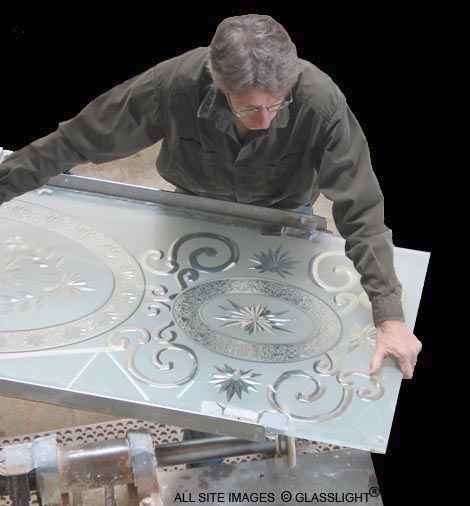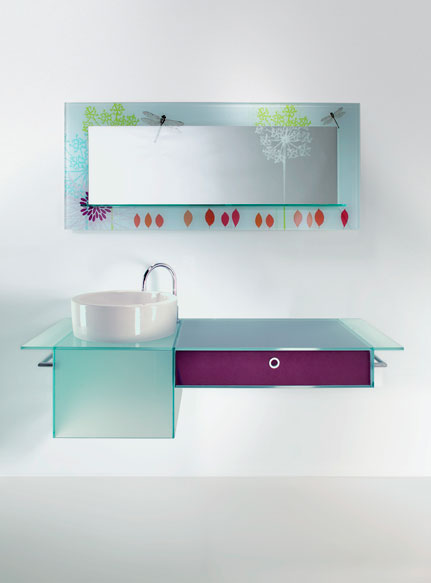












Kiln or oven-formed glass |
| |
| Fused glass |
| |
| Slumped glass |
| |
| Cast glass |
| |
| Sandblasting (etched, carved) Sandblasting begins by masking an adhesive on one side of the glass and then either hand cutting a design or plotting specific shapes with a computer generated image. From there, the "mask" is removed and powerful blasts of compressed air shoot fine grains of clean sand directly onto the unmasked areas. This gracefully "clouds" the surface into a pristine, beautifully opaque state. The amount of sand and the strength of the blast are completely controllable. Individual areas can have masks removed incrementally to deliver a "carved" appearance. Carved glass offers added fluidity, texture and shape. Sandblasted areas are more porous than clear glass; therefore sandblasted glass should be sealed. |
| |
| Glue-chipping |
| |
| Stained Glass (leaded) |
| |
| Tinting and painting
|









Tiny, metallic mosaic tiles transform the backsplash of this serving area, and undercabinet lighting gives it extra sparkle. You can achieve different effects by using different sizes of tiles.


Who says you have to tile the entire kitchen backsplash surface?!?! The creator of this kitchen chose to combine colorful tiles with a fun paint technique. Small tiles in groups of three have been randomly adhered to the painted area beneath the upper cabinets. This is definitely a budget-stretcher.

An elegant marble or granite kitchen backsplash can work beautifully with rich wood cabinets. In this example, the lighter tone of the backsplash and countertops create a visual break between the dark upper and lower cabinets.

Dark grey slate tiles provide a contrast to the simple clean lines of the white cabinetry in this modern kitchen design. In addition to the hit of color, the large size and natural finish of these tiles bring much-needed texture to the space.

The monochromatic color scheme of this kitchen is given a lift with a mosaic tile backsplash. Although the colors for the backsplash have been carried over from the rest of the kitchen, the use of small tiles and a random pattern create visual energy.

This is a mural kitchen tile backsplash by Julia Sweda. Custom tile backplash murals can offer a great focal point of artwork in the kitchen while providing the much needed functionality that backsplashes provide.


The soft, translucent quality of glass tiles has been combined with simpler ceramic tiles for a unique striping effect in this kitchen backsplash design. Using small amounts of more expensive tiles for accents is a great way to add some oomph to your design without breaking your budget.








A glass blower/designer is responsible for designing, producing, decorating and finishing pieces of glass ranging from giftware, tableware, exhibition pieces, stained glass windows, mirrors, ornaments and other architectural glass products through to glass equipment used in scientific laboratories.
Most of the work is carried out by small, independent studios, though there are some larger glass manufacturers based in the UK.
The work can be commissioned by individuals, corporate organisations or the public sector. Most blowers/designers will be involved in the whole commission process, from concept to completion.
Glass blowers/designers may also be involved in restoring, renovating and repairing original pieces.
Depending on the area of specialism, typical work activities may include:
For those running their own business, additional tasks may involve:




